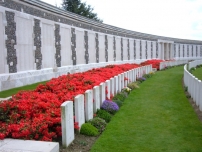| First Name: | Montmorency | Last Name: | BEAUMONT-CHECKLAND | |
|---|---|---|---|---|
| Date of Death: | 17/08/1917 | Lived/Born In: | Belgravia | |
| Rank: | Lieutenant | Unit: | Somerset Light Infantry7 | |
| Memorial Site: | 1. Belgravia, St Peter 23. Tyne Cot Memorial, Belgium | |||
Current Information:Age-33
Third Battle of Ypres This was a campaign fought between July and November 1917 and is often referred to as the Battle of Passchendaele, a village to the north-east of Ypres which was finally captured in November. It was an attempt by the British to break out of the Ypres salient and capture the higher ground to the south and the east from which the enemy had been able to dominate the salient. It began well but two important factors weighed against them. First was the weather. The summer of 1917 turned out to be one of the the wettest on record and soon the battlefield was reduced to a morass of mud which made progress very difficult, if not impossible in places. The second was the defensive arrangements of concrete blockhouses and machine gun posts providing inter-locking fire that the Germans had constructed and which were extremely difficult and costly to counter. For 4 months this epic struggle continued by the end of which the salient had been greatly expanded in size but the vital break out had not been achieved. The Battle of Langemarck This took place between 16th-18th August, 1917 and was the second general attack of 3rd Ypres. Although it did not rain during the two days of the battle itself there had been plenty of it in the preceding days and in many places the battlefield was a quagmire. On the left of the attack in the north-west of the Ypres salient there was considerable success, especially for the French Army which attacked on the left of the British, but the attack on the Gheluvelt Plateau, due east of Ypres, met determined German resistance and the early gains were soon reversed. On 16th August, 1917, 20th Division attacked in the northern part of the Ypres salient, with the Ypres-Staden railway on their left and the village of Langemarck as their immediate objective. 61 Brigade used the 7th Yorkshire Light Infantry and 7th Somerset Light Infantry battalions to attack the first two objectives with the 12th Liverpool (Kings) and 7th Cornwall Light Infantry battalions then passing through to the final objective. They were slightly delayed near Langemarck by a swamp and isolated centres of resistance and also by enfilade fire from Au Bon Gite until that was overcome. Further opposition came from a blockhouse west of Langemarck and later at Langemarck Station but they reached their objective in time for the second wave to pass through and continue the attack. On the following day, 17th August, 7th Somerset were ordered to support an attack by 60 Brigade. Zero hour was 7pm and at 6.30pm battalion HQ was established in the ruins of a house just to the north-east of what remained of the village of Langemarck. The attack met very heavy fire from both in front and from the flanks and two companies of 7th Somerset were pushed forward to support the 12th Liverpool (Kings) battalion that were unable to make progress. In the end the attack came to a standstill and later that evening 7th Somerset were relieved but not before they had suffered over 150 casualties, one of whom was Montmorency Beaumont-Checkland. |
||||
| « Back to Search Results | ||||
| If you think any of the information shown here is incorrect, Click Here to submit your amends and comments | ||||




